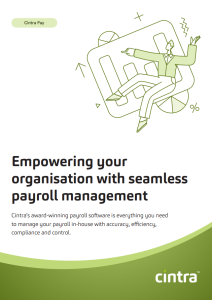Whether you’ve been in business for years or you’re just starting out, understanding the different ways you can pay your employees is vital. Doing this correctly keeps you compliant with HMRC and ensures your staff are happy.
In this easy-to-follow guide, we’ll break down some of the basics of employee pay, giving you clear, digestible information to make your payroll processes smoother.
The definitions
Before we get into the specifics of employee payment methods, let’s make sure we’re clear on some of the key terms and concepts.
Salary
A fixed regular payment, typically paid monthly but often expressed as an annual sum, made by an employer to an employee. It’s usually specified in an employment contract and does not vary with the number of hours worked.
Wage
A regular payment made by an employer to an employee, typically on a weekly or hourly basis. Wages can vary based on the number of hours worked or the amount of work completed.
Weekly pay
The amount of money an employee earns in one week. This can include wages for hours worked, overtime, and any additional bonuses or allowances earned during that week.
Part-month salary
A proportionate payment of an employee’s monthly salary when they do not work for the entire month. This can happen when an employee starts or leaves a job partway through a month. The salary is usually calculated based on the number of days worked.
Backdated pay
Payment that is given for work already done, covering a period before the payment date. This can happen if there was a delay or an error in the original payment schedule. The employer pays the employee the money owed for previous work periods.
Cash in hand payments
Cash in hand pay refers to wages paid directly to an employee in cash rather than through a bank transfer or cheque. While it may seem simple, it comes with significant responsibilities such as declaring and paying the right taxes.
What are some of the different ways you can pay your employees?
Via salary
Salaries offer a reliable way to compensate your team, which benefits both you and your employees.
They make budgeting easier since you know your costs are steady, (except for occasional bonuses or raises). This stability gives your employees financial security, allowing them to plan their finances confidently. Salaried positions often come with good benefits too, which can attract top talent and keep your team happy.
However, remember that fixed hours and potential overtime expectations without extra pay can be tricky. This might make it harder for your team to balance work and personal life, possibly leading to burnout.
Despite these challenges, salaries generally provide predictability and security, making them a solid choice for roles that need stability and commitment in your company.
Via wages
Paying your team hourly wages offers a flexible and cost-effective way to compensate them, benefiting both you and your employees in various ways.
Hourly pay allows you to adjust staffing levels precisely to meet changing business needs, which can save costs and optimise resource use. This setup also gives your employees the flexibility to work overtime during busy periods and manage their personal commitments.
However, it’s important to be aware of potential drawbacks. Hourly wages might lead to higher turnover as employees seek more stable income in salaried roles. Those on lower-hour contracts could experience income fluctuations due to seasonal changes or cost-cutting measures, affecting their financial security.
Via cash in hand payments
Cash in hand payments can be a convenient way to pay your employees. This is especially true if you own a small businesses or have casual workers without immediate access to banking facilities.
The simplicity of handing over cash can save you time and help you avoid the complexities of setting up payroll systems. Employees benefit from immediate access to their wages, which can be crucial for those needing quick funds.
But this way has its downsides. Keeping accurate records is challenging and time-consuming, posing legal risks if tax compliance is not strictly followed. Plus, carrying large amounts of cash can be a security risk, and the lack of traceability means every transaction must be meticulously recorded to avoid potential issues.
Therefore, while cash in hand payments offer convenience and immediacy, they also bring legal, security, and administrative challenges that you need to carefully consider.
Get the latest insights and best practice guides, direct to your inbox.
How to accurately calculate different types of payments
Calculating weekly pay
To calculate weekly pay, you can use one of two methods:
- Annual salary to weekly pay: where you need to divide the annual salary by 52.
For example, if your employee earns £40,000 a year, their weekly pay is approximately £769. (40,000/52 = 769.23)
- Hourly rate to weekly pay: multiply the hourly rate by the total hours worked in the week.
For example, if your employee works 4 twelve-hour shifts a week at £12 per hour they will earn £576.
Calculating part-month salary
To calculate a part-month salary, follow these steps:
- Find your employee’s monthly salary: for example, if your employee’s annual salary is £36,000, their monthly salary would be: £36,000/12 = £3,000
- Identify the number of working days in the month: for example, if you’re calculating salary for June, which has 30 days and starts on a Saturday, there are 20 working days
- Determine the number of days your employee worked: If they started on the 10th of June, you’d count the working days from the 10th to the end of the month, so 15 days in June.
- Calculate your employee’s daily rate: with a monthly salary of £3,000 and 20 working days in June, the daily rate would be: £3,000/20 = £150
- Calculate the part-month salary: multiply the daily rate by the number of days worked. £150 x 15 = £2,250.
Calculating backdated pay
Imagine one of your hourly employee’s received a pay rise from £12 to £14 per hour starting 1st January, but the increase was not applied until 1st March.
To calculate backdated pay follow these steps:
1. Determine the pay difference: new rate (£14) – old rate (£12) = £2.
2.Calculate the shortfall for each month:
- January: 170 hours worked x £2 = £340.
- February: 150 hours worked x £2 = £300.
3. Add the shortfalls for the total backdated pay: £340 + £300 = £640.
4. Apply usual deductions: deduct taxes and other contributions from £640 before paying it out to the employee.
Accurate and automated calculations no matter what type of pay structure you use
We know payroll is complicated, especially if you deal with different payment methods.
But with Cintra, you can rest assured that everyone will be paid on time, every time, by automating calculations and deductions, thereby eliminating the risk of manual errors.
Book a personalised demo today to see either Cintra’s payroll software or outsourced services in action.

Find out more about using Cintra Pay to run accurate, compliant and efficient in-house payroll.
Download your Cintra Pay brochure


